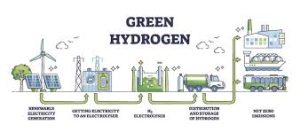Green Hydrogen and Sustainable Energy Solutions

The quest for a sustainable energy future is one of humanity’s most pressing endeavors. As the impacts of climate change become increasingly undeniable, the urgent need to transition away from fossil fuels and embrace cleaner alternatives has never been more critical. Amidst a burgeoning landscape of renewable energy technologies, one element stands out with its immense potential to revolutionize how we power our world: green hydrogen.
While hydrogen itself is the most abundant element in the universe, its presence on Earth is primarily in compound forms, such as water () and hydrocarbons. The key differentiator lies in how this hydrogen is produced. Conventional methods often rely on fossil fuels, resulting in significant carbon emissions. Green hydrogen, however, offers a truly clean pathway, harnessing the power of renewable energy to split water molecules into hydrogen and oxygen through a process called electrolysis. This simple yet profound shift holds the key to unlocking a truly sustainable energy ecosystem.
Understanding the Spectrum of Hydrogen Production:
To truly appreciate the significance of green hydrogen, it’s essential to understand the different methods of hydrogen production, often categorized by color:
- Grey Hydrogen: Produced from natural gas through steam methane reforming (SMR), a process that releases substantial amounts of carbon dioxide. This is the most common method of hydrogen production today.
- Blue Hydrogen: Also produced from natural gas via SMR, but with the crucial addition of carbon capture and storage (CCS) technologies to mitigate the CO2 emissions. While an improvement over grey hydrogen, the effectiveness and cost of CCS remain subjects of ongoing debate.
- Pink/Purple/Red Hydrogen: Produced through electrolysis powered by nuclear energy. These methods are low-carbon but depend on the availability and public acceptance of nuclear power.
- Yellow Hydrogen: Produced through electrolysis powered by solar energy.
- Green Hydrogen: Produced through electrolysis powered exclusively by renewable energy sources such as solar, wind, and hydro. This is the gold standard for clean hydrogen production, resulting in virtually zero greenhouse gas emissions.
Why Green Hydrogen is a Game-Changer for Sustainable Energy:
Green hydrogen possesses a unique set of characteristics that make it an indispensable component of a sustainable energy future:
-
Energy Carrier and Storage Solution: Unlike renewable energy sources like solar and wind, which are intermittent, hydrogen can act as an energy carrier, storing excess renewable energy generated during peak production periods. This stored hydrogen can then be used to generate electricity on demand through fuel cells or combusted directly, providing a reliable and dispatchable energy source. This addresses the inherent variability of renewables and ensures a stable energy supply.
-
Decarbonizing Hard-to-Abate Sectors: Certain industrial sectors, such as steelmaking, cement production, and heavy-duty transportation (shipping, aviation), are notoriously difficult to decarbonize through direct electrification alone. These sectors often require high-temperature heat or energy-dense fuels. Green hydrogen offers a viable pathway to decarbonize these “hard-to-abate” sectors by providing a clean fuel source for industrial processes and powering fuel cell electric vehicles (FCEVs) for long-haul transport.
-
Integration with Existing Infrastructure: In some cases, existing natural gas pipelines can be repurposed to transport hydrogen, albeit with certain modifications and safety considerations. This could potentially reduce the infrastructure costs associated with a widespread hydrogen economy. Furthermore, fuel cell technology can be integrated into existing power grids to provide backup power and grid stabilization services.
-
Circular Economy Potential: The electrolysis process produces pure water as a byproduct, which can be a valuable resource in water-scarce regions. Moreover, advancements in hydrogen production technologies are exploring the use of wastewater and other non-potable water sources, further enhancing its sustainability credentials.
-
Fueling a Cleaner Transportation Sector: While battery electric vehicles (BEVs) are gaining traction for passenger cars, FCEVs powered by green hydrogen offer compelling advantages for larger vehicles and long-distance travel. FCEVs boast faster refueling times and longer ranges compared to their battery counterparts, making them suitable for trucks, buses, trains, and even ships and aircraft.
The Technological Landscape of Green Hydrogen Production:
The cornerstone of green hydrogen production is electrolysis, the process of using electricity to split water into hydrogen and oxygen. Several types of electrolyzers are currently under development and deployment:
- Alkaline Electrolyzers: A mature and cost-effective technology that uses an alkaline electrolyte solution.
- Proton Exchange Membrane (PEM) Electrolyzers: Offer higher efficiency and can operate at higher current densities, making them suitable for coupling with intermittent renewable energy sources.
- Solid Oxide Electrolyzers (SOECs): Operate at high temperatures and have the potential for very high efficiency, but are still in earlier stages of commercialization.
- Anion Exchange Membrane (AEM) Electrolyzers: A promising emerging technology that aims to combine the advantages of alkaline and PEM electrolyzers.
Ongoing research and development efforts are focused on improving the efficiency, durability, and cost-effectiveness of these 1 electrolyzer technologies. Innovations in catalyst materials, membrane design, and stack engineering are crucial for scaling up green hydrogen production and making it economically competitive with fossil fuel-based alternatives.
Beyond Production: The Green Hydrogen Value Chain:
Creating a thriving green hydrogen economy requires a robust value chain encompassing:
- Production: Scaling up electrolysis powered by dedicated renewable energy sources or utilizing surplus renewable energy from the grid.
- Storage: Developing efficient and safe methods for storing hydrogen in various forms, including compressed gas, liquid hydrogen, and solid-state storage.
- Transportation: Establishing infrastructure for transporting hydrogen via pipelines, tankers, or other means.
- Utilization: Deploying hydrogen in diverse applications, including power generation, industrial processes, and transportation.
Each stage of this value chain presents its own set of technological and logistical challenges that require innovation and strategic investment.
Challenges and Opportunities in the Green Hydrogen Transition:
Despite its immense potential, the widespread adoption of green hydrogen faces several challenges:
- Cost Competitiveness: Currently, green hydrogen production costs are higher than those of grey and blue hydrogen. Reducing the cost of renewable electricity and electrolyzer technologies is crucial for achieving economic viability.
- Infrastructure Development: Significant investments are needed in hydrogen production facilities, storage infrastructure, and transportation networks.
- Scalability: Scaling up green hydrogen production to meet future energy demands requires massive deployment of renewable energy capacity and electrolyzer manufacturing.
- Efficiency Losses: Energy is lost during the electrolysis, storage, and reconversion processes. Improving the efficiency of each stage is essential to maximize the overall energy system efficiency.
- Public Awareness and Acceptance: Raising public awareness about the benefits and safety of hydrogen technologies is crucial for fostering widespread adoption.
However, these challenges also present significant opportunities for innovation, economic growth, and job creation. Governments, industries, and research institutions worldwide are increasingly recognizing the strategic importance of green hydrogen and are investing heavily in its development and deployment.
The Global Race to Embrace Green Hydrogen:
Nations across the globe are actively formulating strategies and launching initiatives to capitalize on the green hydrogen opportunity. Countries with abundant renewable energy resources, such as Australia, Chile, and Morocco, are positioning themselves as potential green hydrogen export hubs. Industrialized nations like Germany, Japan, and South Korea are investing heavily in research, development, and pilot projects to integrate green hydrogen into their energy systems and decarbonize their economies.
The European Union has placed green hydrogen at the heart of its Green Deal, outlining ambitious targets for production and utilization. Similarly, the United States is exploring various pathways to accelerate the development and deployment of clean hydrogen technologies through initiatives like the Hydrogen Shot program.
Green Hydrogen: A Cornerstone of a Sustainable Future:
Green hydrogen is not a silver bullet solution to the climate crisis, but it is undoubtedly a crucial piece of the puzzle. By seamlessly integrating with renewable energy sources, it offers a pathway to decarbonize multiple sectors, enhance energy security, and foster a cleaner, more sustainable future for generations to come.
As technology advances, costs decline, and infrastructure develops, the emerald promise of green hydrogen is poised to become a vibrant reality. The journey towards a hydrogen-powered economy will require collaboration, innovation, and unwavering commitment, but the potential rewards – a truly sustainable and resilient energy system – are well worth the effort. The future of energy is not just renewable; it’s increasingly looking green, thanks to the transformative power of hydrogen.











Post Comment